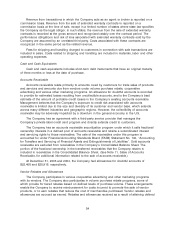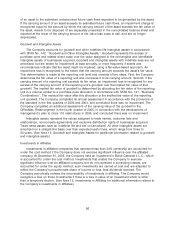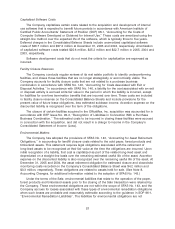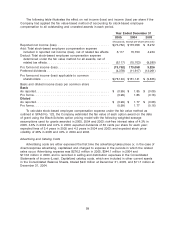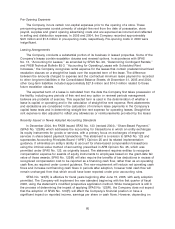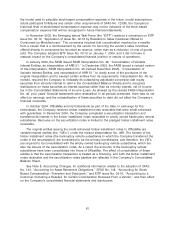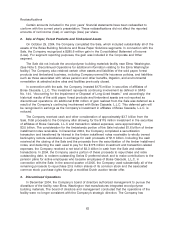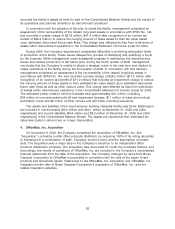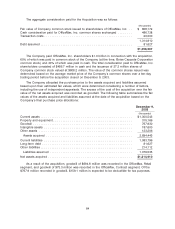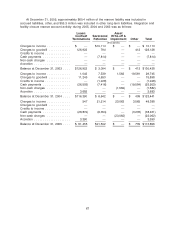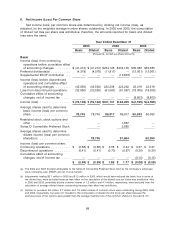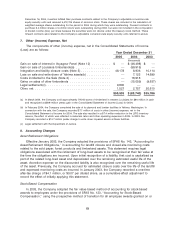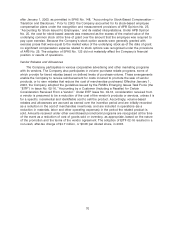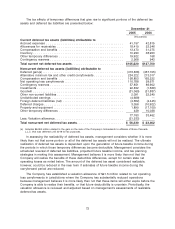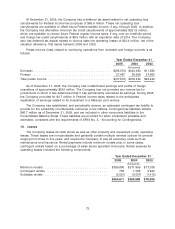OfficeMax 2005 Annual Report Download - page 67
Download and view the complete annual report
Please find page 67 of the 2005 OfficeMax annual report below. You can navigate through the pages in the report by either clicking on the pages listed below, or by using the keyword search tool below to find specific information within the annual report.recorded the facility’s assets as held for sale on the Consolidated Balance Sheets and the results of
its operations and planned divestiture as discontinued operations.
In connection with the adoption of the plan to divest the facility, management completed an
assessment of the recoverability of the related long-lived assets in accordance with SFAS No. 144,
and recorded a pretax charge of $67.8 million ($41.4 million after recognition of an income tax
benefit of $26.4 million) to reduce the carrying amount of these assets to their fair value based
upon estimated discounted future cash flows. This charge was reflected as loss from write-down of
assets within discontinued operations in the Consolidated Statement of Income (Loss) for 2004.
During 2005, the Company experienced unexpected difficulties in achieving anticipated levels
of production at the facility. These issues delayed the process of identifying and qualifying a buyer
for the business. While management made substantial progress in addressing the manufacturing
issues that caused production to fall below plan, during the fourth quarter of 2005, management
concluded that the Company is unable to attract a strategic buyer in the near term and elected to
cease operations of the facility during the first quarter of 2006. In connection with this decision,
management completed an assessment of the recoverability of the related long-lived assets in
accordance with SFAS No. 144, and recorded a pretax charge of $28.2 million ($17.2 million after
recognition of an income tax benefit of $11.0 million) that included an impairment charge to reduce
the carrying amount of these assets to their estimated fair value based upon estimated discounted
future cash flows as well as other closure costs. This charge was reflected as loss from write-down
of assets within discontinued operations in the Consolidated Statement of Income (Loss) for 2005.
The estimated pretax costs to exit this business total approximately $41 million, including
$24 million of non-cash asset write-off and impairment charges, $11 million of lease and contract
termination costs and $6 million of other closure and exit costs, including severance.
The assets and liabilities of the wood-polymer building materials facility near Elma, Washington,
are included in current assets ($0.3 million and $24.1 million at December 31, 2005 and 2004,
respectively) and current liabilities ($9.8 million and $3.2 million at December 31, 2005 and 2004,
respectively) in the Consolidated Balance Sheets. The assets are reported at their estimated fair
value less costs to sell and are no longer depreciated.
4. OfficeMax, Inc. Acquisition
On December 9, 2003, the Company completed the acquisition of OfficeMax, Inc. (the
‘‘Acquisition’’), primarily a retail office products distributor, by acquiring 100% of its voting securities
in exchange for a combination of cash, Company common stock and the assumption of certain
debt. The acquisition was a major step in the Company’s transition to an independent office
products distribution company. The acquisition was accounted for under the purchase method, and
accordingly, the results of operations of OfficeMax, Inc. are included in the Company’s consolidated
financial statements from the date of the acquisition. The Company changed its name from Boise
Cascade Corporation to OfficeMax Incorporated in connection with the sale of the paper, forest
products and timberland assets. References to the OfficeMax, Inc. Acquisition and OfficeMax, Inc.
Integration herein refer to Boise Cascade Corporation’s acquisition of OfficeMax, Inc., and the
related integration activities.
63



